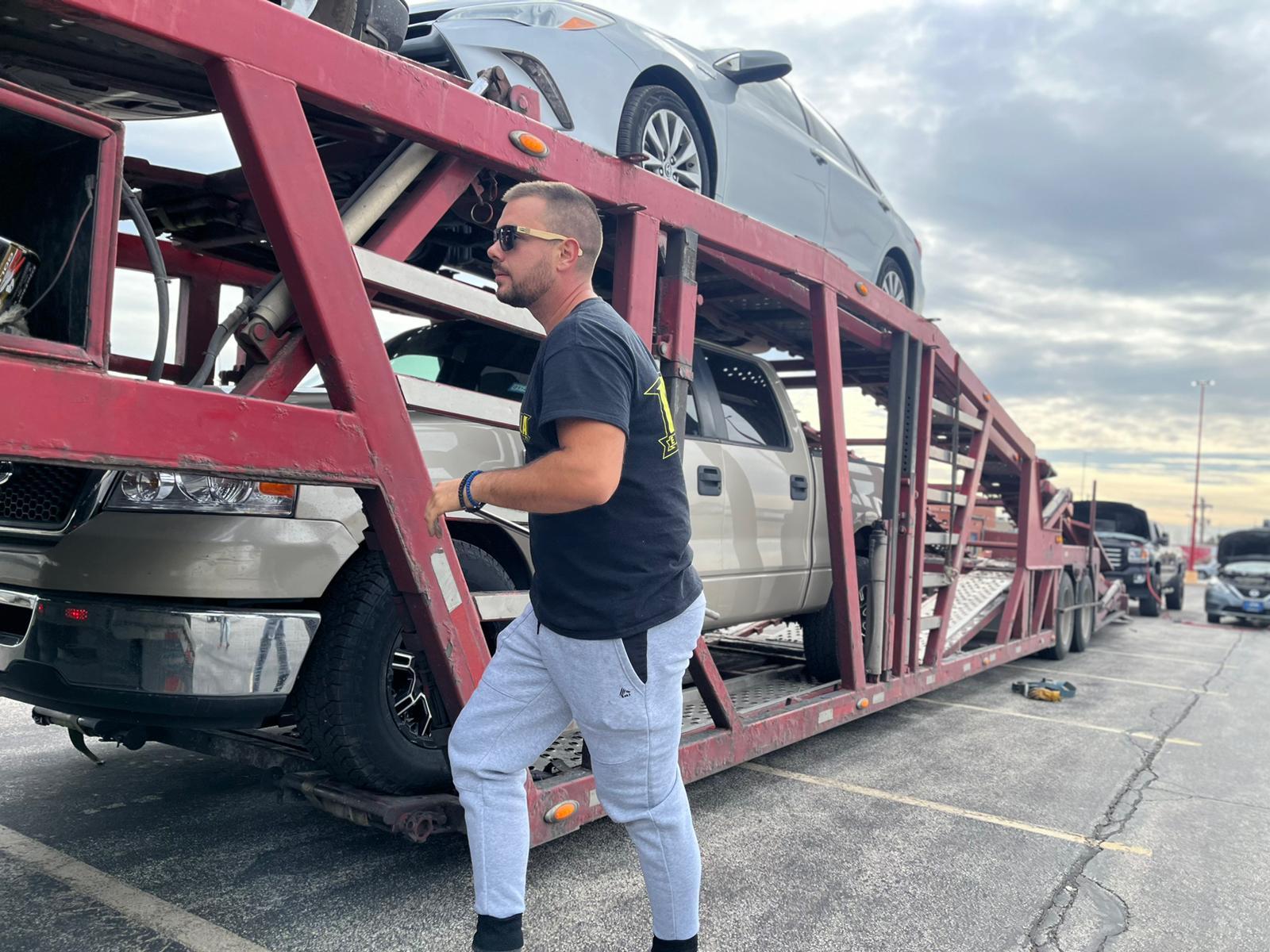The convenience of online car buying is surging, with a whopping 54% of people saying they'd love to buy or sell a car entirely from home. Why? No haggling, no pressure, just a stress-free experience from browsing to purchasing. But what about getting your new wheels home?
Sometimes, delivery can turn into a roadblock, particularly when there are geographical limitations. Fortunately, this guide will walk you through different delivery options to ensure a smooth purchase and delivery. So, let’s begin.
Understanding Your Delivery Options
When it comes to getting a car delivered to your home, there are several options that you can explore. These include:
1. Direct Delivery from Dealer
Getting a vehicle delivered to your home involves selecting and purchasing a car online from a dealership that offers home delivery services. This process simplifies buying a car by eliminating the need to visit a dealership physically or arrange a third-party shipping service.
Process:
Here’s how to get your car delivered from the dealer’s lot to your home:
- Research dealerships or online car sellers that provide delivery services to your area.
- Select a vehicle that meets your preferences and budget. Then, complete the purchase process remotely, which includes filling out the necessary paperwork and making payment.
- Arrange delivery details with the seller, agreeing on a convenient date and ensuring the delivery location is accessible.
- Prepare for the vehicle's arrival by ensuring the designated area is safe for offloading the vehicle.
Cost:
The cost of getting a vehicle delivered from a dealer can range broadly, often between $100 to $1,000, depending on location. Here are some factors that might influence the pricing:
- Distance from the dealership or seller's location to your home.
- Types of vehicles, such as larger or more expensive vehicles, may incur higher delivery fees.
- Delivery speed, with expedited shipping options available at a premium price.
- Promotions or negotiations might lead to reduced or waived fees.
2. Shipping Companies
Shipping a vehicle through professional auto transport companies is a common practice for long-distance or international vehicle relocation. These companies specialize in transporting vehicles safely across states or even countries, offering various services to meet different needs.
Process:
Let’s explore the process of booking a shipping company to deliver the vehicle to your home from the seller’s location:
- Before finalizing your online purchase, confirm whether the seller offers direct shipping options and if they have preferred shipping partners.
- If the seller does not handle shipping, research reputable auto transport companies that can deliver the vehicle from their location to your home.
- Contact several shipping companies for quotes. Provide them with details about the vehicle, the pickup location (the seller's address), and your home address.
- Choose a shipping company based on their quote, services offered, insurance coverage, and reviews from other customers.
- Work with the seller and the chosen shipping company to arrange a pickup date and time. The seller may need to be present to release the vehicle to the shipping company.
- Once the vehicle arrives at your home, thoroughly inspect it for any damage before signing off on the delivery.
Types of Transport: Open vs. Enclosed
Open Transport: Open transport refers to a method of shipping vehicles where the cars are loaded onto an open-air trailer. This type of trailer does not have sides or a roof, exposing the vehicle to external elements.
- Benefits: Lower cost, more availability.
- Drawbacks: Higher risk of damage from weather and road debris.
- Cost Implications: Generally cheaper than enclosed transport.
Enclosed Transport: Enclosed transport is a vehicle shipping method where the cars are transported inside a covered trailer. It is more suitable for shipping high-value, luxury, classic, or antique vehicles that require extra care and protection.
- Benefits: Better protection against weather and debris.
- Drawbacks: More expensive than open transport.
- Cost Implications: Higher costs due to limited space and increased protection.
Cost:
The average cost of having a car shipped to your home by a shipping company in the United States typically ranges from $500 to $1,500. This can vary significantly based on factors such as the distance of the delivery, the type of transport required (open or enclosed), the vehicle’s size, the make and model of the car, and the time of year.
Preparing for Your Car's Arrival
Preparing for the arrival of your car requires careful attention to detail to ensure its condition is preserved and any risk of damage is mitigated. The process involves a series of important steps that you can find in this comprehensive guide:
1. Inspection and Documentation
Upon your car's delivery, the first step is to conduct a detailed inspection. This is crucial for documenting the vehicle’s condition. Here’s what you need to do:
- Start by examining the exterior of your car for any visible damage, such as dents, scratches, or paint discoloration.
- Pay close attention to the windows, mirrors, and lights for any cracks or breakage.
- The inspection should then extend to the car's interior, checking the upholstery, dashboard, and electronic functions to ensure everything is in order.
- Documentation plays a pivotal role in this process; thus, you must photograph any damage, if found, and compare it with the vehicle’s images before transportation. This visual evidence can be invaluable, particularly if you need to address discrepancies or file a claim for damages incurred during transit.
2. Insurance and Liability
With regards to vehicle shipping, there are two types of insurance to consider in general: the carrier's policy and your auto insurance.
The carrier's insurance should cover any damages caused during transport, but it's crucial to verify the specifics of this coverage beforehand. Ask the transport company for a copy of their insurance policy and confirm the extent of coverage, including any deductibles or limits.
It's also advisable to check with your insurance provider. Some personal auto insurance policies offer coverage for your vehicle during transport, which can serve as additional protection. Knowing the details of both policies ensures you're fully aware of where liability lies in the event of damage.
Addressing Discrepancies and Damages
If you discover any discrepancies or damages upon your car's arrival, it's important to address them promptly. Since most transport companies require you to file a claim within a specific timeframe, it’s essential to act quickly. Here’s how you can do so:
- Refer to the documentation and photographs taken before and after transport.
- Present these to the carrier as evidence of any changes in the vehicle's condition to support your case.
- Stay in communication with the transport company and your insurance provider throughout the process.
- If the damage is covered under the carrier's insurance, follow their procedure for claims.
- For damages covered under your insurance, contact your provider to initiate the claim process.
Tips for a Smooth Delivery Process
While the process of buying a vehicle online and getting it delivered to your home is convenient, there are some considerations that you must follow for smooth delivery. These include:
Clear Communication
Once you've selected your vehicle online, it's essential to maintain open lines of communication with both the seller and the chosen transport company.
This involves discussing and confirming all details of the purchase, including the condition of the car, payment terms, and delivery expectations. Regular updates from your delivery partner can help you track the progress of your vehicle's journey to your doorstep effectively.
Flexibility and Timing
When arranging the transport of your car, remember the delivery window can vary. It often depends on factors such as distance, route, and schedules of the shipping company. Therefore, you must discuss and agree upon a realistic delivery timeframe.
Also, be prepared to accommodate some level of flexibility within this window, as unforeseen circumstances like weather conditions or traffic can affect the timing.
Legal and Regulatory Considerations
An often-overlooked aspect of buying a car online is the regulatory considerations that come with it. Before finalizing your purchase, research the requirements in your state regarding these factors. This may include emissions testing, vehicle inspection, and the process for registering an out-of-state vehicle.
Being informed about these requirements will help you ensure that your new car complies with all local laws, preventing any legal issues down the line.
Cost Considerations and How to Save
Vehicle delivery charges can vary widely, influenced by the distance, method of transport, and the service level chosen. For example, longer distances incur higher costs, while the choice between open and enclosed transport would also impact the final price.
Furthermore, opting for premium services, such as expedited delivery, will naturally elevate the charges, making it essential to assess what's truly necessary for your situation. Recognizing these factors is the first step in managing expenses effectively.
Tips for Reducing Costs
Let’s explore some tips that can help you reduce costs:
- Book in Advance: Securing your delivery slot early can lead to better rates and give you a broader selection of transport options.
- Choose Open Transport: Opting for open transport over enclosed can significantly lower costs while still providing safe delivery for your vehicle. However, this does not apply to luxury vehicles.
- Compare Quotes: Choosing quotes from multiple companies allows you to compare prices and services, ensuring you get the best deal available.
Understanding Hidden Fees
Alongside, it’s also important to be aware of potential hidden fees that may increase the overall delivery rates:
- Insurance Surcharges: These fees are additional costs that may be applied to the base rate of shipping to cover various types of insurance coverage beyond the standard liability. Typically, this could include protection against damage or loss during transit.
- Fuel Surcharges: The final quote can fluctuate with fuel prices, potentially affecting the overall cost.
- Remote Delivery Area Fees: Delivering to less accessible areas may incur extra charges, so it's important to clarify these details in advance.
Conclusion
To conclude, it’s crucial to understand different ways when it comes to having your car delivered to your doorstep. Each option, whether direct from the dealer or through a shipping company, presents its own set of processes and implications.
For instance, direct dealer delivery often streamlines the buying process, integrating purchase and delivery with a singular point of contact. Alternatively, opting for a shipping company can offer greater flexibility and possibly more competitive pricing, especially if geographical constraints are a factor.
Therefore, it is vital to consider your specific needs, budget limitations, and overall preferences when deciding on the best delivery method. By making an informed decision, you’ll pave the way for a satisfying online car buying experience, ensuring that your new vehicle arrives at your home safely.


